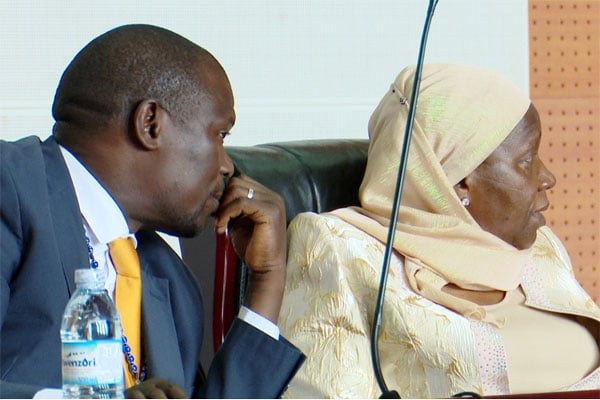Prime
Bee keepers talk about challenges

Nyanzi Frank holding a piece of bee wax at the recent PEWOSA AGRI-BUSINESS Fair in Masaka. Photo/Michael J Ssali
What you need to know:
- The central Region produced the least amount of honey with 169,300 kilograms. Production has improved over the years and today Uganda produces an estimated 4000 metric tons annually and it is expected to grow by 5000 kilograms every year.
Bee keeping is a very important economic activity in the economy of any country because bees are pollinators of many food and cash crops.
Bees make honey which is a natural sweetener and very nutritious food derived from nectar and pollen. They are the source of royal jelly, bee wax, and bee venom.
Beekeeping has a substantial contribution towards employment and poverty alleviation, as has been mentioned in a study report titled: “The Social-Economic Factors Influencing Honey Production in Uganda” by Agnes S Otim, Robert Kajobe,, Joseph Kungu, and Richard Echodu (March 2018).
It is further mentioned in the report: “It is easier and less expensive to operate than any other agricultural income generating activity. There is no need to purchase bee feeds as the bees collect nectar and pollen from available sources of existing natural bee plants.”
It however states that the economic activity is bedeviled by pests, lack of equipment, low prices for bee products, and farm sprays as the main factors affecting honey production.
Potential
The coordinator of Masaka Integrated Bee Producers Association (MIBA), Frank Nyanzi, a resident of Bulayi Village, Mukungwe Sub-county, Masaka City, agrees that beekeeping has a big potential for the economic development of Uganda. “Most people who are unemployed are afraid of taking up bee keeping because they fear bees, which is a flimsy excuse,” he told Seeds of Gold.
“They simply need training in bee keeping. After learning their ways it is possible to live peacefully with bees. The youths further need training in proper handling of honey and other hive products like bee wax, royal jelly and they should also be taught bee venom extraction all of which can be sold by the bee keeper.”
Why beekeeping
Nyanzi also said bee keeping should be one of the most emphasised activities in all government poverty alleviation programmes such as emyoga and Parish Development Model (PDM) by providing the young people going into bee keeping with the necessary equipment, like bee-hives, protective gear, gloves, smokers and bee suits.
He said the youths can also join the honey value chain by making some of the equipment such as bee hives, and protective clothing if given the training, which would be another way of job creation.
Bee hives
He said there are two most common types of beehives used in Uganda, the traditional one woven with dry vines like local baskets, smeared with cow dung and wrapped in a plastic sheet to keep is safe from rain which costs about thirty thousand shillings and the Kenya Top Bar (KTB), made out of timber and metal and costs about one hundred and fifty thousand.
It can be used for several years but the traditional one might not go beyond two or three years. “A farmer using KTB hives may harvest about eight litres from one beehive in a single harvest,” he disclosed. Harvests from the traditional beehive are normally inferior. In Uganda honey is harvested between February and March and between September and October.
Challenges
He is disappointed by the fast decline of the bee population. He attributes it to mindless natural environment destruction by bush fires and cutting down forests where bees would go for nectar and pollen.
According to figures from Uganda Bureau of Statistics (UBOS) Uganda produced 2,609.3 metric tonnes of honey in 2008. The northern region was estimated to have the highest production of honey with 1,274,600 kilogrammes.
The central Region produced the least amount of honey with 169,300 kilograms. Production has improved over the years and today Uganda produces an estimated 4000 metric tons annually and it is expected to grow by 5000 kilograms every year.
Farmer’s experience
Eden Kamugisha, a large scale poultry farmer at Kisagazi in Mukungwe Sub-county, Masaka District is also a bee keeper who aims at owning 800 beehives.
He says beekeeping can be taken up by people who cannot afford to buy land. “They begin with borrowing some space and place a few beehives there or he can enter into an agreement with NEMA and place some beehives in reserved forest land.”
“My real aim is not just to produce honey, bee wax, or royal jelly, but to produce bee venom which is by far more paying,” he says. “I expect to earn several times more than what I currently get from poultry farming. My main disappointment is that there are not enough bees to fill up all the eight hundred beehives that I have bought.”
Today he has just about 300 active beehives out of the 800 beehives that he purchased, which he attributes to the declining bee population, occasioned, according to him, by mindless usage of pesticides and herbicides by crop farmers and the wanton destruction of forests. He also attributes the bees’ decline to pests, vectors, and predators. He mentions rats, snakes, birds, lizards and some insects as the main culprits.
The risk of food shortage due to declining bee population is however disputed by Hank Campbell, author of Science Left Behind, who wrote on March 14:
“Honeybee health --- driving problem is not climate or pesticides but the deadly Varroa mite. Here is the science truth. The 12 crops that provide 90 percent of our food are not pollinated by bees. Some are wind pollinated, some are self-pollinated or propagate asexually or parthenocarpically – they don’t need fertilisation.”
Pests
Diana Namayanja, research scientist/forest etomologist Naro-NaFORRI also mentions Varroa mite as a big problem. She says the insect eats bees and reduces their numbers. She said there are other pests which even cause diseases and illnesses in bees.
“We have to remember that from time immemorial bees lived in the wilderness ---in the forests and jungles --- but we have destroyed their natural habitat which was also their source of nectar and pollen. We are now trying to domesticate them, so we have to provide the environment they were used to,”she said.
Control
Masaka District Principal Entomologist, Godfrey Ssenkaayi, says to protect the bees farmers must be vigilant by regularly inspecting their beehives.
He further says they must exercise high levels of hygiene and avoid mindless application of agricultural chemicals. He goes on to say that bee products like bee venom, beeswax and royal jelly are on high demand these days because of their medicinal value. That is one of the main reasons proper hygiene must be observed by all bee keepers.
Masaka District Principal Entomologist, Godfrey Ssenkaayi, says to protect the bees farmers must be vigilant by regularly inspecting their beehives.




